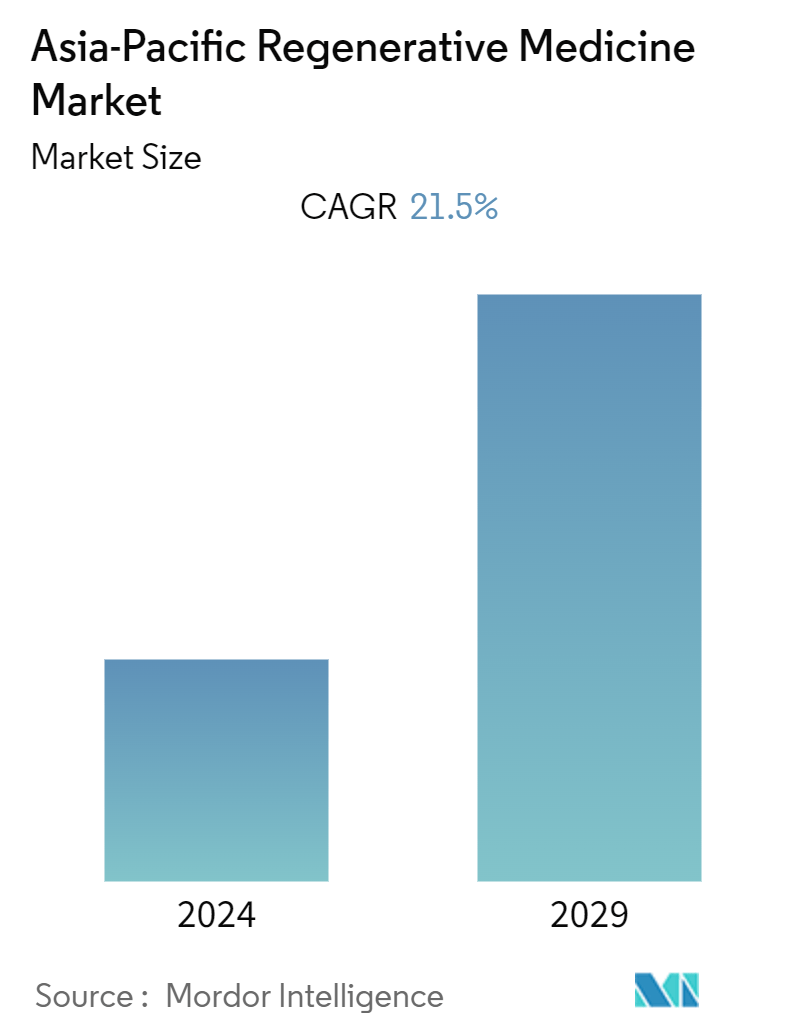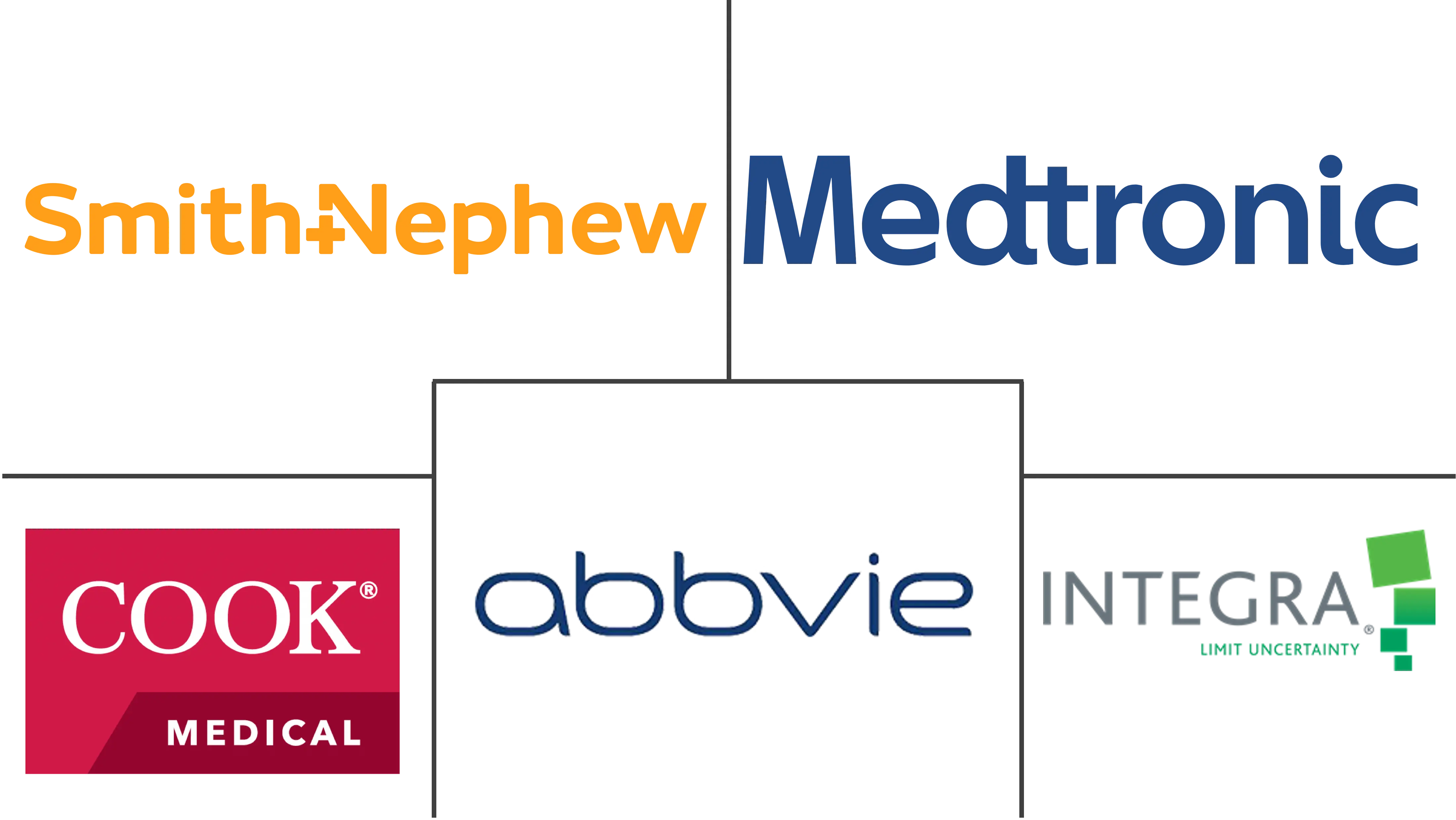Market Size of Asia-Pacific Regenerative Medicine Industry

| Study Period | 2021 - 2029 |
| Base Year For Estimation | 2023 |
| Forecast Data Period | 2024 - 2029 |
| Historical Data Period | 2021 - 2022 |
| CAGR (2024 - 2029) | 21.50 % |
Major Players
*Disclaimer: Major Players sorted in no particular order |
Asia Pacific Regenerative Medicine Market Analysis
The Asia-Pacific Regenerative Medicine Market is expected to register a CAGR of 21.5% during the forecast period.
COVID-19 had a significant impact on the regenerative medicine market across the Asia-Pacific region during the pandemic period. The usage of regenerative medicine in treating COVID-19 diseases and its approvals by regulatory authorities had a crucial impact on the market's growth. For instance, in September 2021, the Central Drugs Standard Control Organization of the Government of India (CDSCO) approved a stem cell-based therapy trial for COVID-19 pneumonia treatment. The clinical trial was conducted in two phases to evaluate the safety and efficacy of Mesocel for treating patients with moderate to severe COVID-19. Such approvals indicated that Asian countries adopted regenerative medicine as a treatment measure for COVID-19, ultimately crucially impacting the market during the pandemic period. In addition, the demand for regenerative medicine is expected to remain intact during the post-pandemic period due to the rising focus on treating various chronic diseases, thereby contributing to the market's growth.
The key factors propelling the growth of the Asia-Pacific regenerative medicine market are the increased funding for regenerative medicine and increasing research and development activities for the development of regenerative medicine. Additionally, the increasing adoption of regenerative medicine for treating various chronic disorders is expected to boost the market's growth over the forecast period. For instance, in February 2022, the Government of India invested over Rs. 8.13 crore (approximately USD 1 million) to support state-of-the-art stem cell research facilities in 40 health research and educational institutions. Further, the report published by the Australian Government in October 2021 stated that the Australian Government is boosting Australian-led stem cell research through USD 25 million in grants. These funds are availed from the Medical Research Future Fund (MRFF). Such government funding in Asia-Pacific is expected to contribute to the market's growth.
Also, in October 2022, Maruti Hospital in Tiruchi, India, introduced a proprietary stem cell treatment for osteoarthritis patients to reduce their dependence on painkillers and provide a more long-lasting solution to knee joint pain. Such increasing adoption of regenerative medicine in treating various disorders is expected to contribute to the market's growth over the forecast period.
However, the high cost of treatments is expected to restrain the market's growth over the forecast period.
Asia Pacific Regenerative Medicine Industry Segmentation
As per the scope of the report, regenerative medicines are used to repair, r eplace, and regenerate the tissues and organs affected by injury, disease, or the natural aging process. These medicines restore the functionality of cells and tissues and are used in several degenerative disorders, such as dermatology, neurodegenerative diseases, cardiovascular, and orthopedic applications. The Asia-Pacific Regenerative Medicine Market is segmented by Type of Technology (Stem Cell Therapy, Biomaterial, Tissue Engineering, Other Types of Technologies), Application (Bone Graft Substitutes, Osteoarticular Diseases, Dermatology, Cardiovascular, Central Nervous System, and Other Applications), and Geography (China, Japan, India, Australia, South Korea, Rest of Asia-Pacific). The report offers the value (in USD million) for the above segments.
| By Type of Technology | |
| Stem Cell Therapy | |
| Biomaterial | |
| Tissue Engineering | |
| Other Types of Technologies |
| By Application | |
| Bone Graft Substitutes | |
| Osteoarticular Diseases | |
| Dermatology | |
| Cardiovascular | |
| Central Nervous System | |
| Other Applications |
| Geography | |
| China | |
| Japan | |
| India | |
| Australia | |
| South Korea | |
| Rest of Asia-Pacific |
Asia-Pacific Regenerative Medicine Market Size Summary
The Asia-Pacific regenerative medicine market is experiencing significant growth, driven by increased funding and research activities in the field. The market's expansion is further supported by the rising adoption of regenerative medicine for treating chronic disorders, such as cardiovascular diseases and osteoarthritis. Government investments in advanced stem cell research and therapies, particularly in countries like India and Australia, are contributing to the market's development. The COVID-19 pandemic also played a role in accelerating the adoption of regenerative medicine, with regulatory approvals for stem cell-based therapies highlighting the region's commitment to innovative treatment solutions. Despite the high cost of treatments posing a challenge, the market is expected to continue its upward trajectory due to the growing focus on chronic disease management and technological advancements.
Japan is poised to hold a significant share of the market, bolstered by its robust research and development initiatives in regenerative medicine. The presence of key market players and technological advancements in healthcare are expected to drive growth in the country. Government support, such as funding from the Japan Regenerative Medicine Project, is facilitating collaboration and development of advanced therapies. The increasing prevalence of chronic disorders, including dementia, is further fueling demand for effective regenerative treatments. The market is moderately fragmented, with major players like AbbVie, Baxter International, and Medtronic PLC actively participating in the region's competitive landscape.
Asia-Pacific Regenerative Medicine Market Size - Table of Contents
-
1. MARKET DYNAMICS
-
1.1 Market Overview
-
1.2 Market Drivers
-
1.2.1 Technological Advancements in Regenerative Medicine
-
1.2.2 Increasing Adoption of Stem Cell Technology
-
1.2.3 Rising Government Initiatives
-
-
1.3 Market Restraints
-
1.3.1 High Cost of Treatments
-
-
1.4 Porter's Five Forces Analysis
-
1.4.1 Threat of New Entrants
-
1.4.2 Bargaining Power of Buyers/Consumers
-
1.4.3 Bargaining Power of Suppliers
-
1.4.4 Threat of Substitute Products
-
1.4.5 Intensity of Competitive Rivalry
-
-
-
2. MARKET SEGMENTATION (Market Size - Value in USD million)
-
2.1 By Type of Technology
-
2.1.1 Stem Cell Therapy
-
2.1.2 Biomaterial
-
2.1.3 Tissue Engineering
-
2.1.4 Other Types of Technologies
-
-
2.2 By Application
-
2.2.1 Bone Graft Substitutes
-
2.2.2 Osteoarticular Diseases
-
2.2.3 Dermatology
-
2.2.4 Cardiovascular
-
2.2.5 Central Nervous System
-
2.2.6 Other Applications
-
-
2.3 Geography
-
2.3.1 China
-
2.3.2 Japan
-
2.3.3 India
-
2.3.4 Australia
-
2.3.5 South Korea
-
2.3.6 Rest of Asia-Pacific
-
-
Asia-Pacific Regenerative Medicine Market Size FAQs
What is the current Asia-Pacific Regenerative Medicine Market size?
The Asia-Pacific Regenerative Medicine Market is projected to register a CAGR of 21.5% during the forecast period (2024-2029)
Who are the key players in Asia-Pacific Regenerative Medicine Market?
Cook Group Incorporated, Integra LifeSciences Corporation, Medtronic PLC, Smith & Nephew plc (Osiris Therapeutics) and AbbVie (Allergan plc) are the major companies operating in the Asia-Pacific Regenerative Medicine Market.

